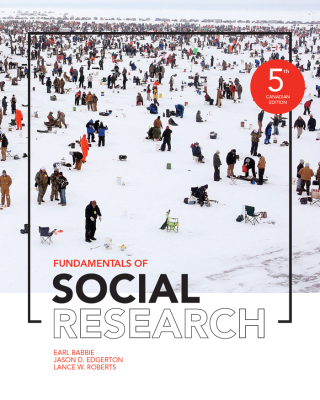Buy FUNDAMENTALS OF SOCIAL RESEARCH 5CE, 5th Edition PDF ebook by author Babbie, Roberts – published by Cengage Learning Canada Inc. in 2021 and save up to 80% compared to the print version of this textbook. With PDF version of this textbook, not only save you money, you can also highlight, add text, underline add post-it notes, bookmarks to pages, instantly search for the major terms or chapter titles, etc.
You can search our site for other versions of the FUNDAMENTALS OF SOCIAL RESEARCH 5CE, 5th Edition PDF ebook. You can also search for others PDF ebooks from publisher Cengage Learning Canada Inc., as well as from your favorite authors. We have thousands of online textbooks and course materials (mostly in PDF) that you can download immediately after purchase.
Note: e-textBooks do not come with access codes, CDs/DVDs, workbooks, and other supplemental items.
eBook Details:
Full title: FUNDAMENTALS OF SOCIAL RESEARCH 5CE, 5th Edition
Edition: 5th
Copyright year: 2021
Publisher: Cengage Learning Canada Inc.
Author: Babbie, Roberts
ISBN: 9780176895952, 9780176896065
Format: PDF
Description of FUNDAMENTALS OF SOCIAL RESEARCH 5CE, 5th Edition:
The fifth Canadian edition of Fundamentals of Social Research provides students with a basis for understanding social scientific research methods within the contexts of their own research projects, published research they consume, and the social world around us. Introducing new Canadian author, Jason D. Edgerton, this fifth Canadian edition engages students by honing their facility for critical thinking, and provides them with essential knowledge, tools, and practical skills they will carry with them into their future academic and professional careers.
Table of Contents of FUNDAMENTALS OF SOCIAL RESEARCH 5CE, 5th Edition PDF ebook:
CoverTitleCopyrightAbout the AuthorsBrief ContentsContentsPrefaceAcknowledgmentsPART ONEAn Introduction to InquiryCHAPTER 1 Human Inquiry and ScienceIntroductionLooking for RealityOrdinary Human InquiryTraditionAuthorityErrors in Inquiry and Some SolutionsWhat’s Really Real?The Foundations of Social ScienceTheory, Not Philosophy or BeliefSocial RegularitiesWhat about Exceptions?Aggregates, Not IndividualsA Variable LanguageExplaining DifferencesVariables, Relationships, and ExplanationsSome Dialectics of Social ResearchIdiographic and Nomothetic ExplanationInductive and Deductive ApproachesQuantitative and Qualitative DataPure and Applied ResearchA Brief Introduction to Mixed Methods ResearchWhy Use MMR?MMR Notational SystemTypes of MMR DesignMain PointsReview Questions and ExercisesContinuity ProjectCHAPTER 2 Paradigms, Theory, and ResearchIntroductionSome Social Science ParadigmsMacro and Micro PerspectivesRationality, Reasonableness, and Objectivity ReconsideredElements of Social TheoryTwo Logical Systems RevisitedThe Traditional Model of ScienceDeductive and Inductive Reasoning: An IllustrationA Graphic ContrastDeductive Theory ConstructionGetting StartedConstructing Your TheoryAn Example of Deductive Theory: Distributive JusticeInductive Theory ConstructionAn Example of Inductive Theory: Multiple KillingsThe Links between Theory and ResearchInspirations for Research AgendasMain PointsReview Questions and ExercisesContinuity ProjectCHAPTER 3 Ethical Issues for Social ResearchersIntroductionThe Ethical Dimension of Social ResearchEthical Codes, REBs, and the Tri-Council Policy StatementUsing Statistics Canada DataEthical Issues in Social ResearchVoluntary ParticipationNo Harm to the ParticipantsAnonymity and ConfidentialityDeceptionAnalysis and ReportingTwo Ethical ControversiesTearoom TradeObserving Human ObedienceInternet-Mediated Research: New Ethical ConsiderationsMain PointsReview Questions and ExercisesContinuity ProjectPART TWO The Structuring of InquiryCHAPTER 4 Research Design and the Logic of CausationIntroductionThree Purposes of ResearchExplorationDescriptionExplanationUnits of AnalysisIndividualsGroupsOrganizationsSocial ArtifactsUnits of Analysis in ReviewFaulty Reasoning from Units of Analysis: Two FallaciesThe Logic of CausationCausal Logic in Nomothetic ExplanationsCriteria for Nomothetic CausalityFalse Criteria for Nomothetic CausalityNecessary and Sufficient ConditionsCausal Logic in Idiographic ExplanationsThe Time DimensionCross-Sectional StudiesLongitudinal StudiesApproximating Longitudinal StudiesMain PointsReview Questions and ExercisesContinuity ProjectCHAPTER 5 Conceptualization, Operationalization, and MeasurementIntroductionWhere Concepts Come FromConcepts, Meanings, and DefinitionsAn Example of Conceptualization and Definition: The Concept of AnomieCreating Conceptual OrderDefinitions in Descriptive and Explanatory StudiesOperationalization ChoicesRange of VariationVariations between the ExtremesA Note on DimensionsDefining Variables and AttributesLevels of MeasurementImplications of Levels of MeasurementSingle or Multiple IndicatorsSome Illustrations of Operationalization ChoicesOperationalization Goes On and OnCriteria for Measurement QualityPrecision and AccuracyReliabilityValidityWho Decides What’s Valid?Tension between Reliability and ValidityIndicators, Indexes, and ScalesIndexes versus ScalesEthics and MeasurementMain PointsReview Questions and ExercisesContinuity ProjectCHAPTER 6 The Logic of SamplingIntroductionA Brief History of SamplingPresident Alf LandonPresident Thomas E. DeweyClinton vs. TrumpPolling in CanadaTwo Types of Sampling MethodsNonprobability SamplingReliance on Available SubjectsPurposive or Judgmental SamplingSnowball SamplingQuota SamplingSelecting InformantsThe Theory and Logic of Probability SamplingConscious and Unconscious Sampling BiasRepresentativeness and Probability of SelectionRandom SelectionPopulations and Sampling FramesTypes of Probability Sampling DesignsSimple Random SamplingSystematic SamplingStratified SamplingMultistage Cluster SamplingMultistage Designs and Sampling ErrorProbability Proportionate to Size (PPS) SamplingDisproportionate Sampling and WeightingSome Realities of SamplingProbability Sampling in ReviewSampling ContentUnits of AnalysisSampling TechniquesMain PointsReview Questions and ExercisesContinuity ProjectPART THREE Modes of Observation: Quantitative and Qualitative ApproachesCHAPTER 7 ExperimentsIntroductionTopics Appropriate to ExperimentsThe Classical ExperimentIndependent and Dependent VariablesPretesting and PosttestingExperimental and Control GroupsThe Double-Blind ExperimentSelecting SubjectsProbability SamplingRandom AssignmentMatchingMatching or Random Assignment?Validity Issues in Experimental ResearchIllustrations of Experimentation”Natural” and Field ExperimentsWeb-Based ExperimentsUsing Existing Online EnvironmentsCreating Your Own Online EnvironmentCollaborating with Existing Online Organizations or CompaniesUsing Crowdsourcing to Conduct Online ExperimentsEthical ConsiderationsStrengths and Weaknesses of the Experimental MethodMain PointsReview Questions and ExercisesContinuity ProjectCHAPTER 8 Survey ResearchIntroductionTopics Appropriate to Survey ResearchGuidelines for Asking QuestionsChoose Appropriate Question FormsOpen-Ended and Closed-Ended QuestionsMake Items ClearAvoid Double-Barreled QuestionsRespondents Must Be Competent to AnswerRespondents Must Be Willing to AnswerQuestions Should Be RelevantShort Items Are BestAvoid Negative ItemsAvoid Biased Items and TermsQuestionnaire ConstructionGeneral Questionnaire FormatFormats for RespondentsContingency QuestionsMatrix QuestionsOrdering Items in a QuestionnaireQuestionnaire InstructionsPretesting the QuestionnaireA Composite IllustrationSelf-Administered QuestionnairesOnline SurveysResponse RatesAn Illustration of an Online SurveyInterview SurveysThe Role of the Survey InterviewerGeneral Guidelines for Survey InterviewingSpecificationsTelephone SurveysComputer-Assisted Telephone Interviewing (CATI)Response Rates in Telephone SurveysComparison of the Different Survey MethodsStrengths and Weaknesses of Survey ResearchEthical ConsiderationsMain PointsReview Questions and ExercisesContinuity ProjectCHAPTER 9 Nonreactive ResearchIntroductionAnalyzing Existing Statistics and Secondary AnalysisDurkheim’s Study of SuicideUnits of AnalysisProblems of ValidityProblems of ReliabilitySources of Existing StatisticsSecondary AnalysisContent AnalysisTraditional Content AnalysisCoding in Content AnalysisSome Illustrations of Content AnalysisStrengths and Weaknesses of Content AnalysisUnobtrusive Online ResearchBig DataSocial Network AnalysisHistorical and Comparative ResearchExamples of Historical and Comparative ResearchSources of Historical and Comparative DataAnalytical TechniquesMain PointsReview Questions and ExercisesContinuity ProjectCHAPTER 10 Field ResearchIntroductionTopics Appropriate to Field ResearchMethodological Terms in Field ResearchEthnography and Participant ObservationCase Study DesignConsiderations in Field ResearchThe Various Roles of the ObserverRelations to SubjectsSome Illustrations of Field ResearchObserving Outlaw BikersParkour in a Canadian CityBeing a Police Officer in Rural CanadaVarious Frameworks for Field Research: Posing and Solving PuzzlesGrounded TheoryExtended Case MethodInstitutional EthnographyParticipatory Action ResearchConducting Field ResearchPreparing for the FieldRecording ObservationsResearch Ethics in Field ResearchStrengths and Weaknesses of Field ResearchValidityReliabilityMain PointsReview Questions and ExercisesContinuity ProjectCHAPTER 11 Qualitative InterviewingIntroductionQualitative Depth Interviewing: Definitions and GuidelinesPreparing for and Conducting InterviewsIn-Depth Interview StudiesFocus GroupsUsing Focus Groups in Social Scientific ResearchTopics Appropriate to Focus Group InterviewsConducting Focus GroupsAdvantages and Disadvantages of Focus GroupsOnline Interviews and Focus GroupsOral HistoryThe Use of Oral History: Some Illustrations and Methodological ConsiderationsAvailable Online DataStrengths and Weaknesses of Oral HistoryMain PointsReview Questions and ExercisesContinuity ProjectCHAPTER 12 Evaluation ResearchIntroductionTopics Appropriate to Evaluation ResearchFormulating the Problem: Measurement IssuesSpecifying OutcomesMeasuring Experimental ContextsSpecifying InterventionsSpecifying the PopulationNew versus Existing MeasuresOperationalizing Success/FailureTypes of Evaluation Research DesignsExperimental DesignsQuasi-Experimental DesignsQualitative EvaluationsThe Social ContextLogistical ProblemsEthical ConcernsUse of Research ResultsSocial Indicators ResearchThe Death Penalty and DeterrenceMain PointsReview Questions and ExercisesContinuity ProjectPART FOUR Analysis of DataCHAPTER 13 Qualitative Data AnalysisIntroductionLinking Theory and AnalysisDiscovering PatternsGrounded Theory MethodSemioticsConversation AnalysisNarrative AnalysisDiscourse AnalysisQualitative Data ProcessingCodingMemoingBringing Order to Data: An IllustrationDeductive Qualitative CodingConcept MappingComputer Programs for Qualitative DataQDA ProgramsEthics and Qualitative Data AnalysisMain PointsReview Questions and ExercisesContinuity ProjectCHAPTER 14 Quantitative Data AnalysisIntroductionQuantifying DataDeveloping Code CategoriesCodebook ConstructionData EntryUnivariate AnalysisDistributionsCentral TendencyDispersionContinuous and Discrete VariablesDetail versus ManageabilitySubgroup Comparisons”Collapsing” Response CategoriesHandling “Don’t Know” ResponsesNumerical Descriptions in Qualitative ResearchBivariate AnalysisPercentaging a TableConstructing and Reading Bivariate TablesIntroduction to Multivariate AnalysisConstructing and Reading Multivariate TablesMain PointsReview Questions and ExercisesContinuity ProjectCHAPTER 15 The Logic of Multivariate AnalysisIntroductionThe Origins of the Elaboration ModelThe Elaboration ParadigmThe LogicThe Application: Four Conventional ModelsTwo Practical ConsiderationsRefinements to the ParadigmMain PointsReview Questions and ExercisesContinuity ProjectCHAPTER 16 Social StatisticsIntroductionDescriptive StatisticsData ReductionMeasures of AssociationRegression AnalysisOther Multivariate TechniquesInferential StatisticsProbability Theory, Sampling Distributions, and Estimates of Sampling ErrorUnivariate InferencesTests of Statistical SignificanceThe Logic of Statistical SignificanceChi SquareMain PointsReview Questions and ExercisesContinuity ProjectCHAPTER 17 Reading, Designing, and Writing Social ResearchIntroductionReading Social ResearchOrganizing a Review of the LiteratureJournals versus BooksEvaluation of Research ReportsUsing the Internet WiselyDesigning a Social Research ProjectGetting StartedKey Design ConsiderationsThe Research ProposalWriting Social ResearchSome Basic ConsiderationsOrganization of the ReportGuidelines for Reporting AnalysesGoing PublicThe Ethics of Reading, Designing, and Writing Social ResearchMain PointsReview Questions and ExercisesAPPENDIXESA Random NumbersB Distribution of Chi SquareC Normal Curve AreasD Estimated Sampling ErrorReferencesGlossaryIndex





